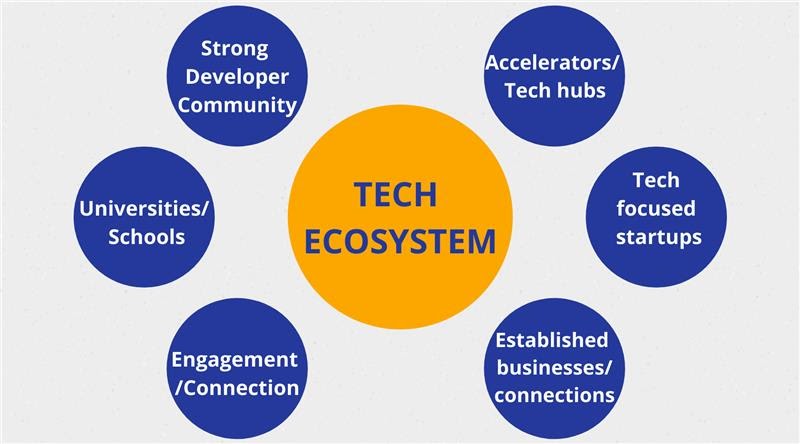Tech ecosystems help economies move forward by creating jobs and wealth. A thriving ecosystem allows founders to connect. They share stories about how to overcome problems they may be facing.
You probably use several — maybe dozens — of business applications daily. It does not matter which department you are sitting in.
That is because no one platform takes care of every business need. It does not matter how comprehensive that platform is.
So, you employ specialized tools for different business functions. This multitude of applications forms your company’s technology ecosystem.
This is the backbone of your business operations. Everything you do sits inside your apps. This ranges from your code to your customer database and business expenses.
This means that making sure you are getting the most out of them is vital to your organization’s success.
Building anything new is hard. Thus, experience sharing should not be under-appreciated.
Additionally, a growing ecosystem unlocked pools of capital. It puts them to work on improving and developing the community further.
Using London as an example, the local ecosystem has evolved from its nascent stages to today’s rivaling New York on a global scale.
This growth has been due to many factors. It is arguably a very complex set of interplaying variables.
However, I want to highlight some of the ones that stand out the most. These are the drivers of a maturing ecosystem.
Understanding ecosystems are vital. This is especially for firms looking to put the user at the forefront of their operations.
What is an Ecosystem

The term “ecosystem” was first used by British ecologist Arthur Tansley in 1935 to describe the relationship between organisms and their environment. In other words, you cannot talk about animals and plants without talking about where they live and function.
Fifty-eight years later, business strategist James F. Moore co-opted the word. He used it to describe the interconnected business world in a Harvard Business Review article.
Moore suggested that companies were not members of a single industry, but rather part of a business ecosystem.
As a part of the business ecosystem, these businesses would co-evolve cooperatively instead of inside a vacuum, attracting similar yet different resources to satisfy customers.
The evolution of the word continues today. Ecosystems now include communities that use shared, scalable resources to pursue challenging objectives and shared interests.
Ecosystems are about dynamic interactions. These are between people, software, data, systems, and services. But what makes them unique is the streamlined flow to grow and transform together.
In today’s digitally connected world, ecosystems are vital to growing existing markets and competing effectively.
What do Ecosystems Look Like?
In the consumer-packaged goods space (CPG), one of the world’s largest manufacturers, expanded its recipe app to become a pantry-management tool, effectively creating an ecosystem.
A user picks their recipes within the ecosystem, which prompts an automatically generated shopping list and seamlessly connects with Peapod, a grocery delivery service.
Delta Air Line’s mobile app is another example. It connects to ride-share services so travelers can order a car when they land. You might also be familiar with the interconnectivity of the health apps on your phone.
Specifically, you likely use an array of apps to track different facets of your health and wellness. It ensures a seamless experience for you.
An ecosystem puts the user’s end-to-end journey at the center of the experience.
You can see then how this quickly creates the need for service providers to work together with one another and how this fact shapes a customer’s overall relationship with the company.
The future of ecosystems will need platforms to be dynamic, open, and therefore integrated. Then they can be functional in real-time. This has been our focus at Nielsen.
Often with partner ecosystems, you are limited to the vendors the company chooses for you, making it hard to reach a broad range of services.
A good ecosystem gives you access to a broad array of partners, with the added flexibility of allowing you to bring your preferred vendors to the network. This drives business value by allowing third parties to access data directly.
In creating an ecosystem centered around the same data—or the same language—clients receive more relevant and accurate results that better align with how they measure business success.
What is the Tech Ecosystem?
A tech ecosystem has five defining features. This is according to the Financial Times’ lexicon guide.
- defined by the platform’s core components. Applications made by autonomous companies complement them in the periphery
- offers solutions comprising a more extensive system of use than the original platform owner created and solves a significant technical problem within an industry
- easy to build upon the core solution. It helps to expand the system of use. Allow new and even unanticipated end uses
- attached with a core firm’s product. It is limited in value when used alone. Increases substantially in value when used with the complementary applications
- includes well-known smartphone platforms, such as Apple and Android, but are also common in gaming consuls and social media platforms. They exist in industrial sectors. These sectors have core products in software, manufacturing, or scientific machinery. These operate as semi-autonomous, value-added resellers
The term “technology ecosystem” can mean multiple things.
If you Google it, you will probably come across various definitions: it can describe a tech scene in a physical location, like London or San Francisco.
A technology ecosystem is also the collection of tech solutions that a particular company uses to run its business. It is about how these solutions connect.
This is the definition we will be working with here.
There is a reason we call it an ecosystem — as opposed to just a “collection of apps” or “app stack,” for example. This is because the term “ecosystem” describes what tools you are using and how they interact with one another.
That same principle can be applied to your technology ecosystem: the key is to figure out how all the elements work together.
The most successful technology ecosystems are integrated in real-time, enabling you to build more functionalities onto your core tools and expand their uses.
For example, let us say you run an online pet supplies store. You sell things like pet food, treats, toys, beds, accessories, cat litter, dog harnesses, etc.
It would help if you likely had an eCommerce tool to run your business. You should have a payment gateway to process customer payments and an accounting tool to keep track of your business finances.
There should also be an email marketing app to send out newsletters and a CRM tool as a database for your customer data. The list goes on.
What is the Make-Up of a Tech Ecosystem?

A tech ecosystem is an interconnected and interdependent network of diverse entities to spur innovation in the tech environment sustainably.
Think of any thriving and robust tech ecosystem (examples: San Francisco and New York), and you will more than likely see all six entities play a significant role.
The strong developer community, accelerators, and tech hubs, tech-focused startups, established businesses and companies, engagement and connections, and Universities and Schools.
Let us break them down further:
-
Strong Developer Community
As technology continues to evolve faster, a vibrant and healthy developer community is critical in any tech ecosystem.
A strong developer community promotes learning. It forces its members to the cutting edge of technology. This ensures that the ecosystem is armed with developer resources to tackle various problems leading to product and service innovations.
The community provides a support system where failure is seen as part of the growth and development journey. This is achieved through engagement and connection.
It is never easy to start a company. But the process can easily be made twice as hard if you do not support your friends, family, and community.
Suppose your family thinks you are insane for not taking that corporate job, and your friends think so well. In that case, there is social friction in the ecosystem, which prevents unlocking innovation.
Tolerance for failure is also important for a culture of entrepreneurial innovation. Failure both in terms of personal failure, but also legal failure. Risk-taking will naturally be discouraged in a culture where failure stays with you for life.
These community aspects are hard to change quickly. But this is something that local governments and schools can help change through targeted campaigns.
E.g., government intervention programs and their success rates in changing popular perceptions such as national health issues.
-
Engagement and Connection
In a thriving ecosystem, constant engagement and healthy business relationships are being formed consistently. Usually, to promote learning and connections, these engagements happen via Meetups/Usergroups and other community events.
At these events, developers meet each other to learn from one another and provide a support system.
It merely takes a village — constant engagement and connection over time builds this village of community members who take and give back to promote growth and sustainability.
-
Established Businesses and Companies
Established tech companies provide opportunities for developers to make a living. However, they support innovation in the ecosystem. Startups can look up to these companies.
More than often, established companies provide meetup spots for the developer community to hold events that encourage learning.
They usually have resources for Research and Development (R&D), which provides other opportunities for developer community members to work on cutting-edge technologies to spur innovation.
In Steve Johnson’s book” Where Good Ideas Come From,” he talks about the power of a network and how the proximity of nodes aids the network’s development speed.
London has exploded since the emergence of TechHub and later on Campus and Tech City to bring together many would-be founders and growing companies.
Now, players like WeWork make co-working spaces a freely available option. New spaces such as Runway East, Second Home, and RocketSpace create alternative communities.
Suppose you visit local buzzing digs such as Ozone Coffee. In that case, it is quite common to see investors and well-known founders intermingling.
It is through this intermingling, that is required to have more ideas and decisions happen.
-
Accelerators & Tech Hubs
Accelerators are critical for sustaining any tech ecosystem. They support early-stage, growth-driven companies through education, mentorship, and financing. They help to accelerate the growth of early-stage startups.
Without accelerators in ecosystems, the ramp-up to growth will take longer. It will possibly discourage or hinder progress.
On the other hand, tech hubs provide physical spaces or environments where tech-enabled startups can work and thrive while networking with other like-minded individuals and startups.
-
Universities & Schools
Universities and schools not only feed rich talent into an ecosystem (which is critical), but they play an essential role in the development of new and innovative tech ideas.
Institutions provide an environment of connections, support, talent to their students and other researchers — and in so doing, foster growth.
Such institutions are also known for helping researchers and students patent their ideas and provide an environment where innovators can test their ideas. University-based hackathons provide student developers the opportunity to ideate and build projects quickly.
For the most part, most large cities have distinguished academic bodies. So it is rarely about capability. It is about offering students a place to experiment with new ideas and providing them with applied internships.
Universities are increasingly developing internal incubators to allow students to exercise a more applied version of their education, leading to new developments or more experienced founders.
In the UK (and increasingly abroad), organizations like Entrepreneur First do a fantastic job of helping graduates meet other talented individuals, creating unique ideas, and forming companies.
Additionally, programs that help teach entrepreneurship to students, such as the NEF, or the public, such as Startup Weekend. This can significantly lead to an increase in the quality of a community’s workforce and an entrepreneurial mindset.
Programs such as CodeFirstGirls and Spear can also be enormous enablers for many community members who wish to enter the tech ecosystem.
-
Availability of HR talent and immigration reform
Experienced individuals are needed in a growing ecosystem.
One quick way of bridging a shortage of staff in an area is to create immigration policies. These allow for talented people to enter the labor force without significant hurdles.
This is an area that many countries struggle with, exceptionally when the local population starts taking a protectionist slant towards employment opportunities.
Nothing helps accelerate an ecosystem’s growth as the importing of highly skilled migrant talent.
in many ways, it led to innovation in this area, initially with the Highly Skilled Migrant Programme (no longer available, unfortunately). The Startup Visa followed it for founders in startups that have received £50K in investment.
Innovations like these have made some great strides in solving this problem for the UK. I am surprised how few other countries have attempted to solve this (Naturally, Brexit will bring some challenges with this, but hopefully, they will be solved).
-
Access to successful mentors or serial entrepreneurs
There are many accomplished firms in Europe. Companies such as Soundcloud, Skype, Transferwise, and more were born out of Europe. Many new European firms are creating technologies in hardware, fin-tech, and other areas.
The challenge for any emerging ecosystem is identifying these people. Find an efficient way for these potential mentors to meet promising new founders.
-
A strong and growing media presence
A successful startup story without an amplifier does not help inspire others to do the same.
The media does highlight success stories. It helps keep the ecosystem honest by bringing to light causes, political initiatives, key players, and even the occasional startup post-mortem. These help founders navigate the emerging local tech industry.
Since 2014, there has been an explosion of media covering tech in Europe, ranging from Techcrunch and Tech. Eu to video channels and podcasts.
-
Access to infrastructure
Building a tech startup is nearly impossible if you do not have access to a reliable and fast internet connection and access to critical services.
These include hosting companies, social networks, and search engines (some countries block these services for various reasons).
A lot of the prior is no longer the UK case. However, it continues to be a problem in other geographies.
Sometimes it is not accessed infrastructure, but rather things like access to data, hosting/processing infrastructure, search engines, and critical internet platforms.
This does mean some countries struggle. But these problems tend to be ones that local governments are almost always keen on resolving quickly.
This is not just for the tech community but also other communities. Censoring may be an issue in your local ecosystem. They can still make things more challenging.
-
Access to experienced capital
Capital comes in many forms, but experienced capital can make a difference to new companies. Experienced capital is not just about prior success. It is about understanding what early-stage startups are like.
Maybe they do not fit the return profile, regularity, forecast-ability, real estate structure, or private equity investments.
Experienced capital also knows how to help founders along their journey. This is rather than just auditing founders how a public company analyst may.
Investors that understand how the global fundraising process works and know how to scale a company are hard to come by, so for sure, any local ecosystem with a few of these is very lucky.
The ecosystem can grow significantly by increasing the knowledge share between these individuals and the rest of the investment community.
-
Tax relief for investors investing in risky companies
Investing in startups can be lucrative. However, you will likely lose on most investments. This is because of its inherent risk.
This has always been a difficult thing for new investors to digest when choosing to invest in startups. They do not experience this in a well-structured financial product from a brokerage firm.
However, tax incentive schemes for investors led by the government can significantly increase the attractiveness of high-risk investments. E.g., the SEIS program in the UK which allows investors to offset income tax and capital gains tax on positive returns on investment,
Ecosystems that have government support to help investors invest more generally manage to unlock stored pools of capital. These can be repurposed to help stimulate the economy.
-
Tax relief for successful founders
Ecosystems may offer founders some sort of tax relief on gains when exiting a business. This can effectively reduce the tax impact.
This allows founders to have more available capital. This program is called Entrepreneur’s Relief in the UK.
Not every exit will leave the founders with a disposable net worth to invest in new startups.
But by creating the structure that encourages this, it merely becomes a numbers game. It is then about how many successful founders contribute to the economy.
Couple this with investor tax incentive schemas. Then you effectively create a virtuous circle of wealth creation that can be repurposed for other wealth creation.
Sure, not every founder will do this, but you need a few to take this up to be beneficial.
-
Access to experienced legal counsel
Experienced lawyers can save a firm time and money. I have seen deals go sour because someone’s counsel was not well-versed in standard terms or venture dynamics.
Lawyers are there to help you make things easier and protect you from things going wrong in the future. But not all ecosystems have legal counsel that is well versed in venture law.
Initiatives such as the series seed term sheets, the BVCA documents, and seed summit term sheets are good starting points in emerging ecosystems. They help to learn about what is expected and what is not.
Then, suppose that there is a mismatch between what you’ve seen and what they are familiar with. This is in the process of evaluating counsel for your company. In that case, that is potentially a red flag.
-
Simplified local legal systems
Part of the legal challenge is finding the right kind of lawyers to hire and having the ecosystem have laws that help support Entrepreneurs.
For example, laws that make it challenging to hire and fire employees make it hard for a startup to control cash burn. As early founders, this will inevitably have to expand and contract as their companies go through natural peaks and troughs.
Simplification of the founder’s legal, bureaucratic burden can make a huge difference. Small things like allowing e-signatures can greatly speed up how quickly deals are completed vs. a notary sign. Other, more complicated structures can slow things down.
Many successful startups come from after a founder has had at least one failure. So, a government’s treatment of company bankruptcy as either a black flag for the founder for evermore or as a state that does not tarnish one’s reputation from being able to try again.
How Tech ecosystems support growth and innovation
Now that we understand what an ecosystem is and what constitutes or makes up an ecosystem, let us look at how ecosystems support growth and innovation sustainably in tech.
Without the critical fabrics of a tech ecosystem, it will be tough for any tech-related startup to succeed. This reminds me of the small portion of my home that cannot grow Bermuda-grass like the other parts of the lawn.
There is soil. It receives enough water, but one specific thing missing is sunlight. Without direct sunlight, it does not matter how much water or fertilizer I will supplement. It only will not grow.
Bermuda-grass is a perennial warm-season grass. This means it comes back every year and grows most actively from late spring through hot summer months.
But the grass will fail to grow without sunlight as part of the ecosystem.
This is how tech ecosystems work. Without a critical ingredient as a University, Strong Developer Community, or Tech-focused startup, it will merely be challenging for any tech-related startup to succeed.
Tech ecosystems do not work in parts. Instead, all the entities are interconnected, intertwined, and interdependent to help support innovation and work as one unit.
Eighty percent of startups fail. This is a known fact. However, investors understand that startups have a “survival chance” when they can pivot to a more successful concept or iterate on the original concept. This happens typically in a thriving ecosystem.
The vibrant tech ecosystem can provide a community of developers. It gives talent, cutting-edge research, and mentors. It provides the opportunity to fail and learn until success becomes the only option.
Building tech ecosystems is not an easy task.
It takes decades of deliberate efforts and investments to bring them to life. The value brings far, outweighs the complexity and time it takes.
Innovation thrives within the fabrics of tech ecosystems. These ecosystems generate enormous economic value. But it does not stop there. It extends beyond the finances of our world and impacts our everyday life.
This platform has enabled the merchant to sell his/her products on the global market. This merchant can now earn more.
Think of the grandparent as a hospice who can now venture throughout the world via virtual reality. Please think of how via machine learning and AI, my thermostat in my home can regulate itself to help me save money while I work.
You get the point. The possibilities are endless. They are only made possible with one key ingredient. The ingredient is sustainable ecosystems.
How to Build the Best Tech Ecosystem
The initial step is to curate existing apps. Identify blockages, disconnects, and information silos. They might be getting in the way of your current processes.
Please get rid of tools that are not working for you and replace them with more suitable apps. Software review websites like G2 Crowd and Capterra can help you with this. They gather feedback on all the top business apps.
Next, identify processes that could be improved. They will be improved by implementing a new app. Then find the best option for you according to your business size, industry, and characteristics.
Make sure your new apps can connect to your existing tools, either natively or through third-party integration software.
You may plan on scaling up your business. Then make sure that your tools are flexible enough to cater to your needs as you grow, not just in the present.
Picking applications that can scale with you will save you the headache of migrating to yet another set of tools further down the road.
Here are a few indicators that a particular tool or application will be able to scale with you as your company grows:
- You can have a free trial of the tool. It will help to test out all of its features before you subscribe.
- Testimonials or customer stories are backing up scalability.
- The vendor offers an affordable starter plan.
- Some packages can suit small businesses and larger ones, with pricing and features fitting the needs of your organization.
The app has more features gated behind extra fees. You can unlock it once you reach the next stage of growth in your business.
Every element in an ecosystem needs to be connected. That is why integrating your software ecosystem is just as important as having the right tools.
How to Connect your Tech Ecosystem
Circling back to the example above, let us say you have chosen all the best apps to run your online pet supplies store. You are happy with the tools in your software ecosystem.
A lot of these apps can already talk to each other natively via in-app integrations.
It is likely that your eCommerce application already offers integration with several payment gateways, for example.
But what if you need more?
For many companies, making sure that their tools are adequately integrated is a big challenge. Most of their applications are not connected, resulting in isolated bits of information.
That is why you need integration software to bridge the gaps between your tools. Make sure you are working with a fully functional software ecosystem. There, your tools play nicely together and talk to each other in real-time.
If the notion of a fully integrated ecosystem sounds daunting to you, do not worry — it is more straightforward than it sounds.
Integration refers to the process of combining two (or more) pieces of software so that they are working in tandem, and this can be achieved in a few different ways.
To integrate your applications, you can use:
-
Native (or In-App) Integrations
These are integrations offered by your software vendor, like the integration between an eCommerce platform and a payment gateway. These may already be included in your subscription.
Native integrations often serve the most common use cases, so they will likely cover the typical workflows users expect to have between apps.
However, they may not cover all of the integration needs for your business in particular.
-
Custom Integrations
If the apps you are using have open APIs, you can have your team build custom integrations in-house. It will be tailor-made for your business needs.
However, they are also typically very costly and time-consuming to build.
Additionally, building custom integrations for all your unique needs is not a feasible option for businesses that do not have employees with the necessary expertise to do this. Building and maintaining software integrations is no piece of cake!
-
iPaaS Tools
Integration Platform as a Service (iPaaS) is a third-party, cloud-based solution specializing in bridging your business tools’ gaps.
This category includes apps like PieSync, which focuses on two-way, real-time syncs to integrate your customer data. It also has Zapier, which specializes in automating workflows between your app’s trigger-action principles.
Most iPaaS solutions offer extensive customization options, so you can tweak your connections until they are doing exactly what you need them to do.
Conclusion
The best apps and integration for you will not necessarily be the most popular, expensive, or comprehensive ones. Adjust your tech ecosystem until it fits you just right. It will help you exceed your goals and boost your performance.
With the right apps for you and the right integrations between them, you will be in the best position to run your business as smoothly as possible.
The future of this ecosystem will continue to empower you. You will continue finding complementary firms that keep pace with consumer needs. They understand the quickly changing consumer landscape.
Just like James Moore mentioned 58 years ago, tech ecosystems are helping you co-evolve cooperatively. It is attracting diverse partners who provide innovative solutions to solve our client’s most difficult challenges.
Whether you are a user of the ecosystem or a contributor to it, plugging in allows you to:
- Improve the user’s experience and journey with you
- Find new customers to sell to
- Find new partners to work with
- Tap into new sources of resources, data, or software
- Improve business processes
Users decide whom they want to engage with. This is based on whose ecosystem they want to be a part of.
It may be about tracking their sleep, connecting their customer relationship management platform, or collaborating on documents. In every case, they commit to ecosystems that can integrate seamlessly with their personal and work environments.
For that reason, companies should design their hardware, software, and services based on what ecosystem will drive that customer value.








